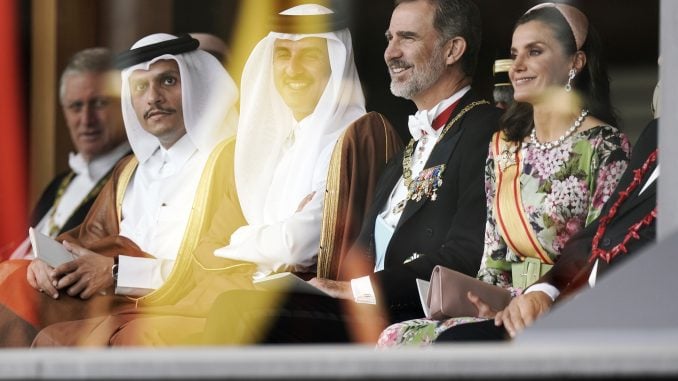
TOKYO — Three booming cheers of “Banzai!” rang out Tuesday at the Imperial Palace in Tokyo as Naruhito formally declared his ascension to the Chrysanthemum Throne as the nation’s 126th emperor.
As a driving autumn rain briefly gave way to sunshine and 2,000 guests looked on, Naruhito pledged at an elaborate, ritual-laden enthronement ceremony to serve as a symbol of the state for his people. Prime Minister Shinzo Abe congratulated him and led the cheers of “Banzai,” which traditionally means “10,000 years.”
The enthronement ceremony is the high point of several succession rituals that began in May when Naruhito inherited the throne after the abdication of Akihito, his father. Naruhito leads the world’s oldest hereditary monarchy, which historians say goes back 1,500 years.
The short ceremony, which some critics say was largely meant to allow Abe’s ultra-conservative government to win public support, was marked by extraordinary contrasts: the rhythmic shuffle of dozens of court dignitaries’ long, stiff, antiquated robes as they brushed over mats leading to the throne room, and the thunder of cannon salutes reverberating through the palace.
The ceremony began with the sound of a bell. Naruhito, wearing a formal brownish-orange robe that was dyed in sappanwood and Japanese wax tree bark and a black headdress decorated with an upright tail, then stood perfectly still while a pair of black-robed chamberlains pulled aside and secured the purple curtains surrounding the throne.
The throne, called “Takamikura,” is a 21-foot high decorative structure resembling a gazebo. It was taken apart in 3,000 pieces and transported last year from the former Imperial Palace in Japan’s ancient capital of Kyoto, where emperors lived until 150 years ago, and reassembled and repaired with new lacquer coatings.
“I hereby proclaim to those inside and outside of the country that I have been enthroned,” Naruhito said. “I hereby swear that I will act according to the constitution and fulfill my responsibility as the symbol of the state and of the unity of the people of Japan, while always praying for the happiness of the people and the peace of the world as I always stand with the people.”
The White House said in a statement that President Donald Trump and first lady Melania Trump offered their “warmest congratulations” to the people of Japan on the occasion. Trump said Naruhito’s imperial era comes at a time the bonds between the two allies “have never been stronger.”
Trump was the first state guest of Naruhito when he and the first lady visited Japan in May just weeks after the succession.
Japanese Emperor Naruhito and his wife, Masako, are hosting a palace banquet for some 400 guests including foreign royals and dignitaries following his enthronement ceremony.
Naruhito changed into a formal tailcoat decorated with medals, while Masako wore a long white dress and a tiara. They greeted their guests before they started a seated dinner of Japanese cuisine.
Guests included Prince Charles of Britain, U.S. Secretary of Transportation Elaine Chao, Sultan Hassanal Bolkiah of Brunei, King Carl XVI Gustaf of Sweden, King Felipe and Queen Letizia of Spand, and King Willem-Alexander and Queen Maxima of the Netherlands.
Earlier Tuesday, Naruhito, dressed in a traditional costume, proclaimed himself as Japan’s 126th emperor at the Imperial Palace, months after he succeeded the Chrysanthemum Throne in May after his father abdicated.
Naruhito, who studied at Oxford, is a historian, a viola player and an expert on water transport. Naruhito’s wife, Masako, is a Harvard-educated former diplomat.
